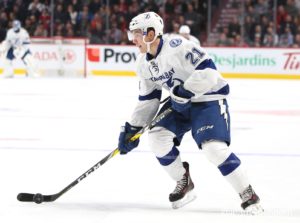Brayden Point of the Tampa Bay Lightning is one of those unpredictable rookies who debuted the NHL this season. Selected at No. 79 in the third round of the 2014 Draft, the 20-year-old centreman is only 5-foot-11 and weighs a mere 165-pounds. Compared to Mitch Marner, one of the Toronto Maple Leafs’ top rookies who’s been highly publicized for his small size, Point is five pounds lighter than him. This is said to be one of the reasons why he was only drafted in the third round.

What makes Point’s potential challenging to project is his relatively high level of skill combined with his small size. The concern is that his size will be more of a setback than anything else. Point served as team captain for the WHL’s Moose Jaw Warriors for the last two seasons before he came to Tampa Bay and left the Warriors 2015-16 regular season with a point-per-game played (P/GP) rate of 1.83. He also served as captain for Team Canada at the World Junior Championships last year. It’s safe to say the potential is there but the concern regarding his size is also understandable.
If you take a look at some of the scouting reports about Point, the consensus is that he has good vision and plays smart, which is how he manages to stay competitive against players bigger than himself. It looks like the Tampa Bay Lightning are in the process of finding an optimal balance for Point in terms of using his mind and body on the ice efficiently.
Let me explain.
Describing Point’s Play-Per-Period
Based on Point’s first 29 NHL games played, he averages 15:21 of ice time per game.
- 33.2% of TOI was spent in first periods
- 33.6% of TOI was spent in second periods
- 32.6% of TOI was spent in third periods
- 0.6% of TOI was spent in overtime
There also doesn’t appear to be a strong correlation between the amount of time Point does or does not spend on the ice each game and efficiency. Although Point has only played in one game with more than 18:00 minutes of ice time (Vs. Boston on Nov. 27), it appears that his performance is influenced more so by strategy. This seems like a perfect fit for a guy who’s known for having an acute ability to see and play smart. After taking a look at the enhanced analytics of Point’s game, which can be found on the NHL’s website, I’ve accumulated a list of Point’s events and categorized each event within the period they occurred. The role Point plays in the Lightnings’ system has unique identifying markers indeed and his actions in each period differ dramatically from one period to the next.
Let’s take a look.
#TBLightning Brayden Point celebrates as he scores his first #NHL goal beating #Devils G Schneider as #bolts go up 3 to 1 in p3. #NHL pic.twitter.com/Gc2Dl1AQdM
— Dirk Shadd (@DirkShadd) November 6, 2016
Period 1: Physically Active
During first periods, Point is by far the most physical, as 64 percent of hit’s given (H/G) occurred during this period. Consequently, 59 percent of hit’s received (H/R) also occurred during first periods. Point has a surprisingly high number of hits received too. In fact, two percent of all Point’s events (excluding faceoffs) were hits received and that’s Point’s second-largest segment of event types. For every hit he gives, he receives 2.5 hits in return. Even though the majority of hits given occur in the first period, the high number of hits received may have more to do with Point’s size than a reaction to hits given. To sum it up, Point is more likely to get hit during first periods and has incurred more than half of all hits received during the first period of each game played.
Point received an accumulative 2.7 attempted shots blocked (A/B), missed shots (M/S) and shots on goal (SOG) per game played. Slightly more than a third (35 percent) occurred during first periods, while 32 percent occurred in both the second and third periods. This tells us that Point “directs his shots” to goal slightly more often during first periods but maintains relative consistency each period in doing this.
If we exclude Point’s faceoffs from his list of events per game, Point incurs the most events during first periods (38 percent of total events occurred during first periods versus 31 percent in both the second and third periods). Although this isn’t a big difference, it could shed light on ways to increase positive events and decrease negative ones. For example, Point is least likely to give the puck away during first periods. Only 18 percent of giveaways (GvA) occurred during first periods and this is his fewest giveaways per period. Perhaps correlations can be found between physicality and puck giveaways as these two aspects of his role are the biggest differentiating features of his game in first periods.
To summarize, Point is extremely physical in first periods compared to other periods. He saw a slight increase in shots, missed shots and attempted shots on goal and a big decrease in giveaways.
Period 2: Psychologically Primed

Point’s focus dramatically shifts during second periods and his average shift length increased by nine percent. During this period, Point’s entire mood changes and he exercises great control over his actions. First, he reduces the number of times he hits opponents by 71.4 percent (only 18 percent of hit’s given occurred during second periods).
Second, Point slightly increases his shots on goal (SOG increased by 17.7 percent). Point’s largest segment of event types, not including faceoffs are shots on goal (33 percent of events excluding faceoffs are SOG). In second periods, Point shoots on goal more often than in other periods (38 percent of total shots on goal were reserved for second periods).
Third, Point’s missed shots decreased by 66.7 percent (only 13 percent of total missed shots occurred in second periods). This shows us his aim becomes significantly more accurate during second periods and that’s he’s less likely to miss the net when shooting on goal.
Shot Types
Furthermore, of all Point’s attempted shots blocked, missed shots and shots on goal, 53 percent were wrist shots. Point uses backhand and snapshots interchangeably. For every 4.1 wrist shots taken, Point utilized a backhand or snapshot.
Point has yet to make a tipped-in shot on goal, a tipped-in missed shot or a tipped-in attempted shot on goal in a second period as well, even though tip-ins are his second-most utilized shot type (16 percent of SOG are tip-ins). He actually reserves the mass majority of tip-ins to third periods.
Finally, only one percent of Point’s points were registered during second periods. He’s also more likely to give away the puck during second periods as well (45 percent of giveaways occurred during second periods).
To summarize, Point significantly reduces his physicality during second periods and completely refrains from tipped-in shots on goal. Perhaps this absence of tip-ins explains why his aim significantly improved in second periods. However, his giveaways incurred increased (although not by very much) and he’s only registered one point during this period to date (an assist on Nov. 17 vs. Buffalo).
Period 3: The Tipping Point
http://gty.im/621675352
During third periods, Point’s mood changes yet again. In this period, he maintains closer proximity to the net. Seventy-five percent of his shots and missed shots on goal that were five to 10 feet away from the net occurred during third periods. On top of that, 75 percent of tip-ins occurred during third periods as well. This likely explains why he’s more likely to miss the net during this period, statistically speaking. Fifty percent of Point’s missed shots occurred during third periods and 38 percent of missed shots were tip-ins.
In hockey, tip-in shots are shots on goal involve the shooter positioning himself in any area near the net and redirecting an incoming shot with his stick. A deflected shot is a shot that changes direction because it made contact with a player before hitting the net/goalie. Tip-in shots are essentially planned deflections and they require a great deal of skill. In this article published by the New York Times back in 2012, ‘Tipping Shots, and Often the Balance of Games’, Martin Brodeur, David Clarkson and Joe Nieuwendyk speak to the intricacies involved in puck deflecting. Described as an art form, mastering this skill requires a particular bravery and can yield great fruits. Bravery is something that Point certainly has and perhaps that’s why he’s in pursuit of mastering the tip-in shot on goal.
When it comes to attempted shots blocked, though, Point is less likely to have his shots on goal blocked during third periods (only one attempted shot has been blocked in third periods). This may also be correlated to tip-in shots as they tend to be harder to block. The same goes for blocking shots. Point has yet to block a shot in any third period and this may support the observation made about spending more time in closer proximity to the opposition’s net.
Finally, even though Point placed most of his focus on shooting during second periods, the only two times he’s scored goals were in third periods. Seventy-three percent of Point’s points were registered during third periods. Point’s first goal scored was on Nov. 5 against the New Jersey Devils and it was a tip-in shot. His second goal was on Nov. 19 against the Philadelphia Flyers and it was a wrist shot.
Brayden Point: First NHL Goal
To summarize, Point sets himself up in front of the net during third periods and waits for the next shot on goal to come his way. By doing this over and over again, he’s developing a skill that will hopefully make him a master of tip-ins one day. The popular belief that this role requires a big man capable of taking additional abuse from the defensive opposition is losing its credibility as Point proves it’s about having big character and showing bravery in tough places.
As we can see, Point’s size clearly plays a role in his game, especially in first periods. This isn’t a bad thing, though. He’s simply showing opponents he’s ready for whatever they have waiting for him in the third period. Point is capable of handling the physical elements of the game and he’s facing them head on. He demonstrates excellent emotional stability in doing this, which in turn, helps him manage diverse states of mind throughout each period. Point is a prime example of how perceived weaknesses can be turned into strengths when there’s a will to do so.